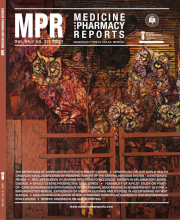Knowledge and perception of dental practitioners regarding the use of devitalizing agents
DOI:
https://doi.org/10.15386/mpr-1820Keywords:
formocresol, surveys and questionnaires, pulpitis, painAbstract
Background. Pulpal pain is amongst the most severe pains experienced by humans. Various chemical agents are used routinely to devitalize the severely inflamed pulpal tissue. Most of these agents are harmful and have detrimental effects. This questionnaire-based study evaluated the awareness and perception of dental practitioners regarding the use of devitalizing agents during endodontic procedures, and various alternatives to minimize the use of these agents.
Methods. An open questionnaire was distributed to a total of 250 dental practitioners. It carried detailed information about the most common devitalizing agent used, the purpose of use, method, and duration of application, recommendations, complications encountered, awareness of complications, and various alternatives. The collected data were subjected to statistical analysis using SPSS (Statistical Package for Social Sciences) version 17.0 (IBM Statistics, Chicago, Illinois, USA). Descriptive statistics were drawn with respective percentages to have a comparative overview.
Results. 209 responses to 250 questionnaires circulated gave a response rate of 83.6%. Amongst them, 63.15% of dentists were using devitalizing agents. The most widely and frequently used devitalizing agent was Devitec (PD Swiss, Vevey, Switzerland) (36.3%), followed by Caustinerf forte (Septodont, Saint-Maur-des-Fosses, France) (29.5%). A total of 32.9% dentists were aware of the recommendations, and 66.02% were aware of the complications of devitalizing agents; 16.26% of dental practitioners encountered complications due to the use of devitalizing agents. The dentists listed the alternate methods regarding the use of pulp devitalizing agents.
Conclusion. Although most of the dentists were aware of the harmful effects and few encountered complications with the use of devitalizers, they continued to use these agents because of the lack of an effective alternative.
Downloads
Published
How to Cite
Issue
Section
License
The authors are required to transfer the copyright of the published paper to the journal. This is done by agreeing to sign the Copyright Assignment Form. Whenever the case, authors are also required to send permissions to reproduce material (such as illustrations) from the copyright holder.

The papers published in the journal are licensed under a Creative Commons Attribution-NonCommercial-NoDerivatives 4.0 International License.

